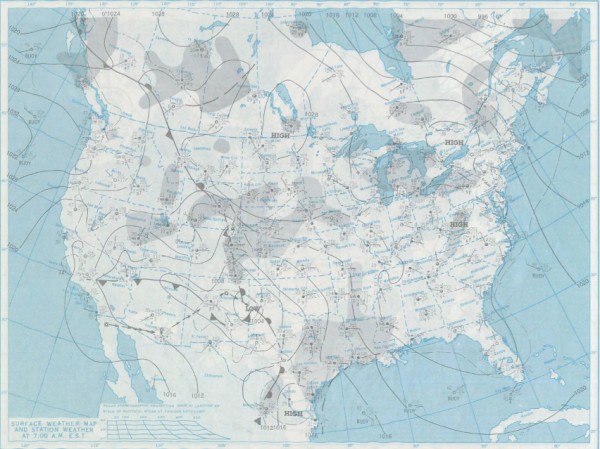The January 1982 WInter Storm
A powerful cold front moved through Birmingham on Saturday, January 9, 1982, sending temperatures plummeting. The high on Saturday was 49F, but it was down to 27F by midnight and the mercury was in a free fall like I had never seen. It was bitterly cold all day on Sunday, with the mercury slowly inching through the teens along with a powerful north wind and a few snow flurries. But even more interesting things were on the way. The NOAA Weather Radio that morning gave the standard two day forecast with a three day extended outlook. It called for rain or snow Tuesday night. That is all that a snow fan needed to hear, and with temperatures expected to drop to near zero, the prospects of some wintry precipitation had to be promising.
The morning low on Monday was 2F. The 500 mb chart told the story. A huge vortex was over Quebec, and a cross polar flow was delivering cold air straight into the Southeast. The mercury struggled back up to 27F on Monday, but with the high close by Monday night, winds went dead calm and the mercury plunged to –1F at the Airport during the evening hours. But in response to developing low pressure in the Gulf, cloud cover increased, and by midnight, it was back up to a balmy 13F.
Morning forecasts on the 12th had called for a winter storm watch for occasional sleet and freezing rain that would arrive by sundown. By mid-morning, as freezing rain and sleet across South Alabama was spreading rapidly north, the watch was changed to a winter storm warning. The snow arrived about 8 hours earlier than anticipated in the Birmingham area and quickly changed over to a mix of freezing rain and sleet that turned roads in skating rinks. Thousands of motorists had to abandon their vehicles on roads and hike home or spend the night in shelters. One suburban shopping mall became a huge shelter. So many wrecks occurred that the Birmingham Police Department could not answer the calls for accident investigation.
As temperatures hovered near the freezing mark through the night, freezing rain created a thick coating on all exposed objects. Trees snapped, pulling down power lines and putting as many as 750,000 Alabamians in the dark. Travel became possible for a short while on Wednesday, as temperatures rose to just above freezing at lunch. But the sound of tree limbs snapping under the weight of the ice was like shotguns.
An upper level disturbance brought a nice snowfall on Wednesday night that led to some great sledding and snowball fights on Thursday. But when it was all said and done, twenty Alabamians were dead and another 300 injured and damage totaled $78 million.
Category: Alabama's Weather, Met 101/Weather History


















